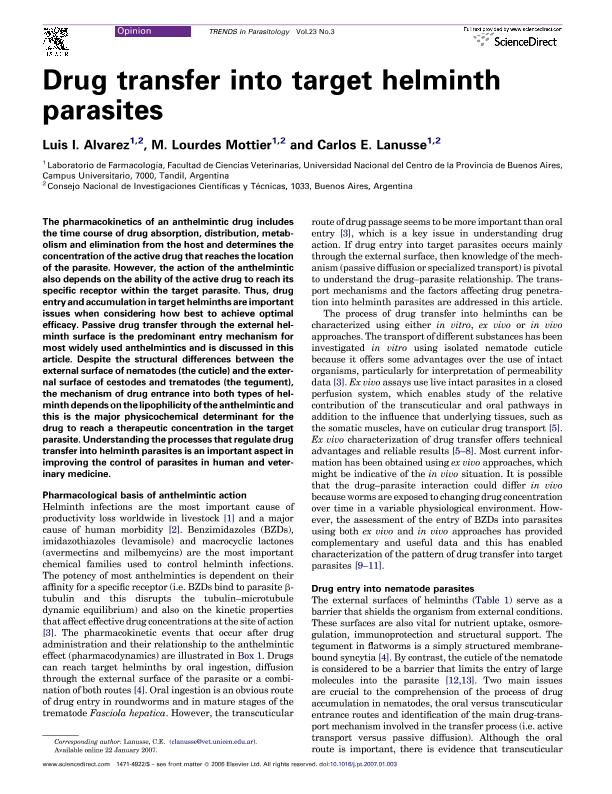Mostrar el registro sencillo del ítem
dc.contributor.author
Alvarez, Luis Ignacio

dc.contributor.author
Mottier, Maria de Lourdes

dc.contributor.author
Lanusse, Carlos Edmundo

dc.date.available
2020-04-27T19:24:59Z
dc.date.issued
2007-03
dc.identifier.citation
Alvarez, Luis Ignacio; Mottier, Maria de Lourdes; Lanusse, Carlos Edmundo; Drug transfer into target helminth parasites; Elsevier; Trends In Parasitology; 23; 3; 3-2007; 97-104
dc.identifier.issn
1471-4922
dc.identifier.uri
http://hdl.handle.net/11336/103680
dc.description.abstract
The pharmacokinetics of an anthelmintic drug includes the time course of drug absorption, distribution, metabolism and elimination from the host and determines the concentration of the active drug that reaches the location of the parasite. However, the action of the anthelmintic also depends on the ability of the active drug to reach its specific receptor within the target parasite. Thus, drug entry and accumulation in target helminths are important issues when considering how best to achieve optimal efficacy. Passive drug transfer through the external helminth surface is the predominant entry mechanism for most widely used anthelmintics and is discussed in this article. Despite the structural differences between the external surface of nematodes (the cuticle) and the external surface of cestodes and trematodes (the tegument), the mechanism of drug entrance into both types of helminth depends on the lipophilicity of the anthelmintic and this is the major physicochemical determinant for the drug to reach a therapeutic concentration in the target parasite. Understanding the processes that regulate drug transfer into helminth parasites is an important aspect in improving the control of parasites in human and veterinary medicine.
dc.format
application/pdf
dc.language.iso
eng
dc.publisher
Elsevier

dc.relation
http://hdl.handle.net/11336/58534
dc.rights
info:eu-repo/semantics/openAccess
dc.rights.uri
https://creativecommons.org/licenses/by-nc-sa/2.5/ar/
dc.subject
DRUG TRANFER MECHANISMS
dc.subject
HELMINTH PARASITES
dc.subject
RESISTANCE
dc.subject.classification
Ciencias Veterinarias

dc.subject.classification
Ciencias Veterinarias

dc.subject.classification
CIENCIAS AGRÍCOLAS

dc.title
Drug transfer into target helminth parasites
dc.type
info:eu-repo/semantics/article
dc.type
info:ar-repo/semantics/artículo
dc.type
info:eu-repo/semantics/publishedVersion
dc.date.updated
2020-04-17T14:39:22Z
dc.journal.volume
23
dc.journal.number
3
dc.journal.pagination
97-104
dc.journal.pais
Países Bajos

dc.journal.ciudad
Amsterdam
dc.description.fil
Fil: Alvarez, Luis Ignacio. Consejo Nacional de Investigaciones Científicas y Técnicas. Centro Científico Tecnológico Conicet - Tandil. Centro de Investigación Veterinaria de Tandil. Universidad Nacional del Centro de la Provincia de Buenos Aires. Centro de Investigación Veterinaria de Tandil. Provincia de Buenos Aires. Gobernación. Comision de Investigaciones Científicas. Centro de Investigación Veterinaria de Tandil; Argentina. Universidad Nacional del Centro de la Provincia de Buenos Aires. Facultad de Ciencias Veterinarias. Departamento de Fisiopatología. Laboratorio de Farmacología; Argentina
dc.description.fil
Fil: Mottier, Maria de Lourdes. Consejo Nacional de Investigaciones Científicas y Técnicas. Centro Científico Tecnológico Conicet - Tandil; Argentina. Universidad Nacional del Centro de la Provincia de Buenos Aires. Facultad de Ciencias Veterinarias. Departamento de Fisiopatología. Laboratorio de Farmacología; Argentina
dc.description.fil
Fil: Lanusse, Carlos Edmundo. Consejo Nacional de Investigaciones Científicas y Técnicas. Centro Científico Tecnológico Conicet - Tandil. Centro de Investigación Veterinaria de Tandil. Universidad Nacional del Centro de la Provincia de Buenos Aires. Centro de Investigación Veterinaria de Tandil. Provincia de Buenos Aires. Gobernación. Comision de Investigaciones Científicas. Centro de Investigación Veterinaria de Tandil; Argentina. Universidad Nacional del Centro de la Provincia de Buenos Aires. Facultad de Ciencias Veterinarias. Departamento de Fisiopatología. Laboratorio de Farmacología; Argentina
dc.journal.title
Trends In Parasitology

dc.relation.alternativeid
info:eu-repo/semantics/altIdentifier/doi/http://dx.doi.org/10.1016/j.pt.2007.01.003
dc.relation.alternativeid
info:eu-repo/semantics/altIdentifier/url/https://www.cell.com/trends/parasitology/fulltext/S1471-4922(07)00004-9
Archivos asociados
